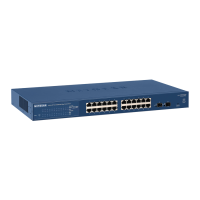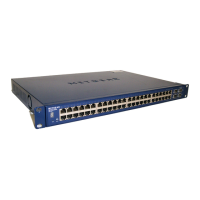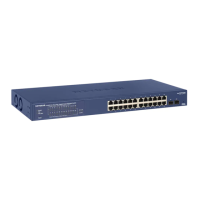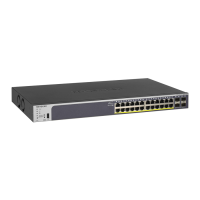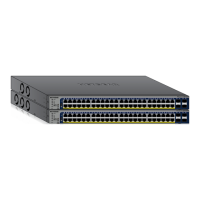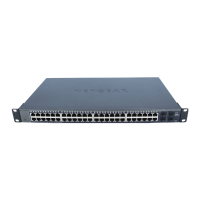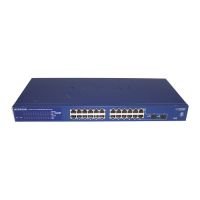154
GS716T and GS724T Gigabit Smart Switches
To configure CoS settings for an interface:
1. To configure CoS settings for a physical port, click PORTS.
2. To configure CoS settings for a Link Aggregation Group (LAG), click LAGS.
3. To configure CoS settings for both physical ports and LAGs, click ALL.
4. Select the check box next to the port or LAG to configure. You can select multiple ports and
LAGs to apply the same setting to the selected interfaces.
5. From the Interface Trust Mode field, specify whether or not the selected interface(s) trust a
particular packet marking when the packet enters the port.
• Untrusted. Do not trust any CoS packet marking at ingress.
• 802.1p. The eight priority tags that are specified in IEEE 802.1p are p0 to p7. The
QoS setting lets you map each of the eight priority levels to one of eight internal
hardware priority queues.
• DSCP. The six most significant bits of the DiffServ field are called the Differentiated
Services Code Point (DSCP) bits.
6. From the Interface Shaping Rate field, specify the maximum bandwidth allowed on the
selected interface(s). This setting is typically used to shape the outbound transmission rate
in increments of 64 kbps. This value is controlled independently of any per-queue maximum
bandwidth configuration. It is effectively a second-level shaping mechanism. The default
value is 0, in increments of 16. A value of 0 means the maximum is unlimited.
The expected shaping at egress interface is calculated as:
(frameSize × shaping × 64) ÷ (frameSize + IFG), where IFG (Inter frame gap) is 20 bytes,
frameSize is the configured frame size of the traffic, and shaping is the configured traffic
shaping in the Interface Shaping Rate field.
For example, when a 64 byte frame size and 64 kbps interface shaping rate are
configured, the expected shaping will be approximately 3121 kbps.
7. Click Cancel to cancel the configuration on the screen and reset the data on the screen to
the latest value of the switch.
8. If you make changes to the page, click Apply to apply the changes to the system.
